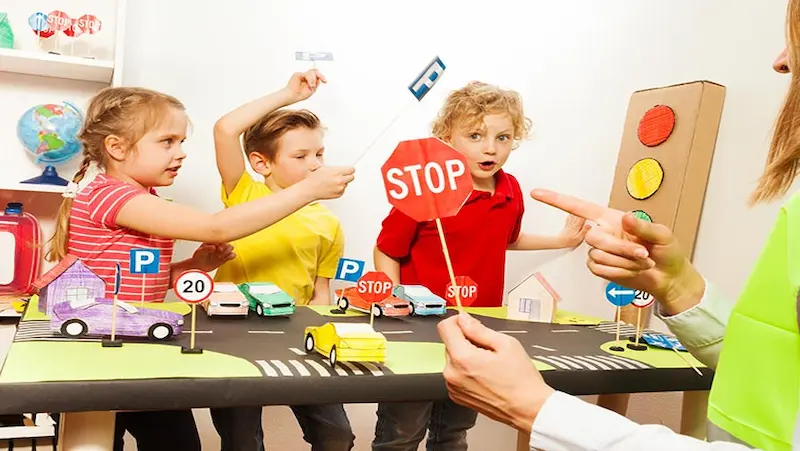Are you sick of having to arbitrate disputes between your quarreling kids all the time? Parenting can be difficult when there is sibling rivalry, but don’t worry! We’ll look at expert advice and techniques in this area to help you raise peaceful kids. You may establish a calm and loving environment where siblings learn to get along and look out for one another by putting these tried-and-true methods into practice.
Table of contents
- Introduction
- 1. Encouraging Communication and Active Listening
- 2. Promoting Individuality and Celebrating Differences
- 3. Establishing Clear Family Rules and Expectations
- 4. Encouraging Cooperation and Teamwork
- 5. Teaching Conflict Resolution Skills
- 6. Avoiding Comparisons and Favoritism
- 7. Allocating Individual Quality Time
- 8. Encouraging Sibling Bonding Activities
- 9. Being a Positive Role Model
- 10. Seeking Professional Help When Needed
- Conclusion
- Frequently Asked Questions
Introduction
Effective parenting techniques and a thorough comprehension of the dynamics at work are necessary for managing sibling disputes. Instead of only addressing the issues on the surface, it is imperative to deal with the underlying causes of rivalry. With the appropriate strategy, you may help your children achieve enduring sibling harmony that will benefit them throughout their lives as well as settle problems.
In this section, we will delve into ten expert tips that have been proven successful in soothing sibling rivalry. From communication techniques to conflict resolution strategies, we will equip you with the tools necessary to navigate even the most challenging situations. So, sit back, relax, and get ready to transform your household into a harmonious haven for your beloved children.

1. Encouraging Communication and Active Listening
Siblings should always be open and honest with one another for a variety of reasons. It serves as the cornerstone of wholesome relationships, encourages empathy, helps resolve disputes, and deepens the tie between siblings. Here are some important details emphasizing the value of direct and honest communication:
Transparent communication fosters a culture of trust between siblings. Trust is established and preserved when people can express their ideas, emotions, and worries without worrying about being judged or punished. Strong sibling relationships are built on trust
Open communication helps siblings better understand one another’s viewpoints, experiences, and feelings. This fosters understanding and empathy. Siblings can empathize with one another by openly communicating their views and feelings, generating a sense of support and connection.
2. Promoting Individuality and Celebrating Differences
Fostering a supportive and inclusive atmosphere requires promoting individuality and celebrating diversity. It can have a significant impact on a child’s self-esteem, confidence, and general development to acknowledge and respect each child’s distinctive personality and interests. The following are some methods for emphasizing the value of uniqueness:
Make a welcoming and secure environment: Create a space where kids can express themselves without worrying about criticism or humiliation. Encourage open dialogue and encourage kids to respect and celebrate diversity.
Feature a range of role models: Introduce youngsters to a variety of people from various backgrounds who have succeeded in various professions. Showcase their successes and draw attention to how their special traits and hobbies led to their achievement.

3. Establishing Clear Family Rules and Expectations
A healthy and happy family dynamic is facilitated by setting clear expectations and boundaries within the family.
Enhanced Communication: A framework for open and successful communication within the family is provided by clear rules and expectations. Everyone can communicate their ideas, worries, and needs more confidently and honestly when they are aware of their limitations and expectations. This fosters closer ties among family members by establishing a culture of communication, respect, and understanding.
Resolution of Conflict: Having clearly stated expectations and boundaries might aid in avoiding disagreements in the first place. Misunderstandings and conflicts are avoided when everyone is aware of the boundaries and knows what is expected of them.
4. Encouraging Cooperation and Teamwork
Fostering a sense of teamwork and collaboration among siblings brings numerous benefits to their personal growth and relationship. By working together, siblings develop essential social skills, empathy, and the ability to compromise. It creates a supportive environment where they learn to appreciate each other’s strengths, communicate effectively, and solve problems as a team.
Practical activities and strategies to promote cooperation and mutual support include setting shared goals and tasks, such as planning and organizing family activities. Encouraging siblings to work on projects together, like building a puzzle or creating a family newsletter, promotes collaboration.
Engaging in team-building games or sports activities also fosters cooperation and encourages them to rely on each other. Additionally, reinforcing positive behavior and resolving conflicts through open communication and active listening can strengthen their bond and promote a harmonious sibling dynamic.

5. Teaching Conflict Resolution Skills
It is important to teach children conflict resolution techniques so they can navigate their social interactions and acquire lifelong skills for handling disagreements in a healthy and productive way. The following are some good methods for teaching kids conflict-resolution skills:
Children learn a lot by watching adults, so it’s crucial to set a good example for conflict resolution in your relationships. When handling issues in your own life, show excellent communication, active listening, empathy, and problem-solving abilities.
Teach active listening: An essential skill in conflict resolution is active listening. Children should be taught to listen intently to others without interjecting, passing judgment, or thinking up responses in advance. To ensure understanding, encourage them to repeat back what they have heard.
6. Avoiding Comparisons and Favoritism
Comparing siblings and favoritism within a family can seriously harm the development and well-being of the children concerned. The following are some of the negative effects:
Self-esteem damage can result from frequently being compared to a sibling, which can cause feelings of inadequacy and a decline in self-esteem. Children may form a poor self-image and think they are less desirable or capable if they are frequently made to feel inferior to their siblings.
Comparisons frequently promote sibling rivalry and competition, resulting in strained relationships and a hostile home environment.

7. Allocating Individual Quality Time
Individual focus: Children thrive when their parents give them individual focus. A youngster feels appreciated, heard, and understood when you spend time with them one-on-one. The parent-child tie is strengthened and deeper connections are made possible.
Interactions that are tailored: Every child is different in their needs, interests, and strengths. You can customize your interactions to suit each person’s unique preferences by providing personal quality time to each person. They feel valued and gain self-confidence as a result of this customized attention.
8. Encouraging Sibling Bonding Activities
Engaging in activities that promote bonding among siblings is crucial for building strong relationships and fostering positive interactions. Shared experiences create lasting memories and deepen the sibling bond. Here are some ideas for activities that can strengthen sibling relationships:
1. Family Game Nights: Set aside dedicated time for playing board games, card games, or video games as a family. This encourages cooperation, and healthy competition, and strengthens the sibling bond.
2. Outdoor Adventures: Plan outings such as picnics, hikes, or bike rides where siblings can explore nature together. These activities promote teamwork, and communication, and create opportunities for shared adventures.
3. Arts and Crafts: Encourage siblings to collaborate on creative projects like painting, crafting, or building models. Working together fosters creativity, and problem-solving, and enhances their ability to work as a team.
4. Cooking or Baking Together: Involve siblings in preparing meals or baking treats. This allows them to work together, follow instructions, and appreciate the value of cooperation in achieving a common goal.
The benefits of shared experiences include improved communication skills, empathy, mutual respect, and the development of lifelong bonds. Engaging in these activities helps siblings develop a sense of belonging, strengthen their emotional connection, and create a supportive and loving family environment.

9. Being a Positive Role Model
Parents play a significant and influential role in shaping sibling relationships. The way parents interact with and guide their children can greatly impact the dynamics and bonds between siblings.
Setting a positive example: Parents serve as role models for their children. When parents demonstrate love, respect, and kindness in their interactions with each other and their children, siblings learn important lessons about how to treat one another.
Encouraging communication and conflict resolution: Parents can teach siblings effective communication skills and conflict resolution strategies. By providing opportunities for open and honest dialogue, parents can help siblings express their thoughts and emotions, understand each other’s perspectives, and find peaceful resolutions to disagreements.
10. Seeking Professional Help When Needed
An essential first step in overcoming sibling rivalry is admitting the need for professional intervention. Although arguments and disagreements between siblings are common, there are times when the rivalry escalates or becomes destructive, negatively affecting the well-being of both parties. In these situations, consulting a professional might offer helpful direction and assistance. Here’s how you should handle it:
Recognize the symptoms: It may be time to think about seeking professional treatment if the sibling rivalry is causing severe discomfort, interfering with daily activities, or developing into physical or emotional harm.
Choose the right professional: Depending on the severity of the situation, there are various professionals who can assist, including family therapists, psychologists, counselors, or mediators.
Discuss your concerns: Express your concerns openly with both the siblings involved and other family members. Emphasize the importance of seeking professional help and explain that it’s a positive step towards improving the family dynamics and fostering healthier relationships.

Explore more about free coding for kids
Conclusion
This blog post highlights expert tips for fostering harmony among children and creating a nurturing environment at home. The key points discussed include:
- Understanding individual needs: Recognize that each child is unique and has different needs, strengths, and interests. Tailor your parenting approach accordingly.
- Effective communication: Encourage open and respectful communication among siblings. Teach them to express their feelings, needs, and concerns constructively, fostering understanding and empathy.
- Conflict resolution skills: Teach children conflict resolution strategies, such as active listening, compromising, and finding win-win solutions. Help them develop problem-solving abilities and promote peaceful resolutions.
- Encouraging teamwork and cooperation: Promote a sense of teamwork and cooperation among siblings. Engage them in collaborative activities where they can learn to work together, share responsibilities, and appreciate each other’s contributions.
Also, BrightChamps provides a comprehensive platform for learning about money for kids, offering interactive and engaging resources that teach financial literacy, budgeting, saving, and other essential money management skills.
Frequently Asked Questions
Sibling rivalry is a common phenomenon experienced by many families. It occurs due to various factors such as competition for parental attention, perceived inequalities, personality differences, and developmental changes, leading to conflicts and the need to establish individual identities within the family dynamic.
Signs that sibling rivalry is becoming problematic may include frequent physical or verbal aggression, constant arguments, extreme jealousy, persistent resentment, and a negative impact on the emotional well-being of one or more siblings.
Despite the fact that it can happen at any age, sibling rivalry can also vary in severity and presentation. Sibling rivalry can occur at any age, but it is often more pronounced during childhood and adolescence when siblings are in close proximity and competing for attention, resources, and parental approval.
Parents can differentiate between normal sibling rivalry and more serious conflicts by considering the intensity, duration, and impact of the conflicts on the well-being and safety of the children involved.
Effective strategies for preventing sibling rivalry escalation include setting clear expectations, promoting individuality, providing equal attention and resources, teaching conflict resolution skills, and encouraging positive sibling interactions.
Parents can foster a positive sibling relationship from an early age by promoting love, respect, and cooperation, encouraging shared activities, praising positive interactions, and facilitating open communication and problem-solving.
Parental behavior plays a crucial role in mitigating sibling rivalry. Modeling positive communication, avoiding favoritism, addressing conflicts calmly, and providing a supportive and fair environment helps reduce rivalry and promote healthy sibling relationships.
Yes, activities and games that can help siblings bond and reduce rivalry include cooperative games, team-building activities, collaborative art projects, and shared hobbies or interests that encourage siblings to work together and enjoy each other’s company.
When addressing conflicts between siblings, it’s important for parents to remain neutral and avoid taking sides. Act as a mediator, listen to both sides, validate their feelings, encourage empathy, and guide them toward finding mutually acceptable solutions.
Teach siblings effective communication and conflict resolution skills by encouraging active listening, using “I” statements to express feelings, teaching problem-solving techniques, promoting empathy and understanding, and facilitating calm discussions to resolve conflicts.


 We are an army of educators and passionate learners from BrightChamps family, committed to providing free learning resources to kids, parents & students.
We are an army of educators and passionate learners from BrightChamps family, committed to providing free learning resources to kids, parents & students.







